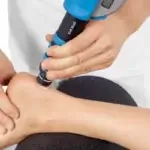Amid the changing outline of pain treatment, Shockwave Therapy stands out as a masterpiece of innovation that provides a counter perspective to traditional techniques. The State Line Chiropractic Center is a front-runner in integrating the most advanced treatments with holistic recovery to highlight Shockwave Therapy’s different powers. This comprehensive investigation not only dispels the myth of Shockwave Therapy but also situates it in the broader spectrum of possible pain relief alternative practices and assists patients in making the most informed decision possible regarding their path to overall health.
Understanding Shockwave Therapy
Since the therapeutic means has not been in use for an impressive amount of time, the signification of Shockwave Therapy can be disregarded by many. However, the approach is fully safe and requires no interventions because it is based on ensuring that the body takes care of the rest. As a result of increased blood circulation and stimulated natural healing processes, Shockwave Therapy can be applied even in quite severe cases, whether they are mostly of a non-chronic matter or, conversely, a long-existing disease.
The Mechanism Behind Shockwave Therapy
In essence, Shockwave Therapy operates on producing a set of high-energy pulses which pierce the skin and the tissue to access the treated area. The impacts that ensue following this treatment ensure an increased rate of blood flow and the growth of new blood vessels, which means that this procedure can trigger the intrinsic healing process of the body. Additionally, Shockwave Therapy has the potential to disintegrate calcifications and fibrous tissue, enabling pain alleviation and improved mobility.
Traditional Pain Treatment Methods
In contrast, traditional pain treatment methods, including medication, physical therapy, and in some cases, surgery, have been the cornerstone of pain management for decades. Each approach carries its own benefits and drawbacks, shaped by the specifics of the patient’s condition, the severity of the symptoms, and personal health goals.
Medication
From over-the-counter painkillers to prescribed opioids, medicine provides the quickly required fix; only when it comes to long-time use, side effects and dependency dampen the benefit.
Physical Therapy
Physical therapy is a core source of rehabilitation that is put into use for manual therapies, exercises, and modalities like heat and ice for pain. Very effective but often needs full commitment and relatively a lot of time for recovery.
Surgery
Surgery, the most invasive option, is reserved for cases where other treatments have failed. On the one hand, it does offer the promise of definitive solutions; however, risks, long recovery periods, and possibilities of postoperative complications are balanced against them.
Shockwave Therapy vs. Traditional Methods: A Comparative Analysis
Efficacy and Speed of Recovery
Shockwave Therapy stands out for its rapid results and effectiveness, particularly in cases where traditional methods have plateaued. Patients often report significant improvements in pain and function within a few sessions, a stark contrast to the gradual progress typical of physical therapy and the variable outcomes of medication and surgery.
Non-Invasiveness and Safety
Unlike surgery, Shockwave Therapy maintains the integrity of the skin and underlying structures, virtually eliminating the risk of infection or complications. This non-invasive nature also means no downtime, allowing patients to return to their daily activities immediately.
Long-Term Outcomes
Shockwave Therapy not only addresses the symptoms but also promotes tissue regeneration, offering long-term improvements rather than the temporary relief commonly associated with pain medication. This focus on healing at the source holds the potential to reduce the likelihood of recurrence, a limitation often encountered with traditional methods.
Making the Right Choice for Your Health
The decision between Shockwave Therapy and standard models of pain management is influenced by the nature of the diagnosis, the level of symptom manifestation, and one’s health-related goals. No matter which alternative one chooses, at State Line Chiropractic Center, our professionals will be with you every step of the way to make the decision that appeals to one’s road to recovery.
Consultation and Personalized Care
To get started on identifying the root cause of your problem and developing an optimal treatment plan, we will first need to conduct a detailed evaluation. Our professionals will review your medical history, conduct a comprehensive physical examination, and perform diagnostic imaging if necessary. Thanks to such an approach, the plan we develop will help relieve your pain and ensure long-lasting health.
Embracing Innovation for Better Outcomes
At State Chiropractic Line Center, we see the difference that innovation can make in changing lives. One example is Shockwave Therapy is one element of our mission to provide progressive, evidence-based treatments. Allowing cutting-edge methods with conventional chiropractic approaches will allow our patients to reach their health potential and uncover new paths to manage pain.
Conclusion
Therefore, as the medical field continues to probe and push the limits of what pain treatment can accomplish, Shockwave Therapy is a vital viable, and compelling solution. Given its difficult-to-come-by combination of efficacy, high safety profile, and potential for relief that might span for years to come, it is a beacon of hope for everyone avoiding the risks of invasive surgery. State Line Chiropractic Center is pleased to lead the way in this direction, using the most advanced care available to guarantee your health. Visit our website and start your journey to a healthier life today!
FAQS
Shockwave Therapy is the application of acoustic waves to painful spots of the body to stimulate healing.
This will effectively work out the tendinitis, heel spurs, elbow, and shoulder pain, and other cases related to chronic musculoskeletal conditions.
This works by sending high-energy pulses to the affected area, hence increasing blood flow, breaking fibrous tissue, and heightening the body’s natural process of healing.
Patients most often experience some discomfort during the therapy, even though the rest is well-tolerated; some modifications could be done regarding patients’ comfort level to the extent that they would feel comfortable.
Its session number depends on the condition and response of the individual but usually comprises 3 to 5 sessions.




